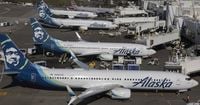Alaska Airlines, a major U.S. carrier based in Seattle, found itself at the center of a travel maelstrom this week after a significant information technology outage brought its operations to a grinding halt across the country. The disruption, which began around 3:30 p.m. Pacific Time on Thursday, October 23, 2025, was traced to a failure at the airline’s primary data center—a technical snafu that sent ripples through airports, left tens of thousands of passengers stranded, and forced the company to issue a rare nationwide ground stop for all Alaska and Horizon Air flights.
The immediate impact was staggering. According to Reuters, more than 229 flights were canceled in the initial hours of the outage, and by Friday afternoon, the tally had soared to over 400 canceled flights. The chaos was not limited to canceled departures; airports like Seattle-Tacoma International and Los Angeles International reported dozens of delays and additional cancellations as the airline scrambled to get its systems back online and reposition aircraft and crews. AP reported that 82 Alaska Airlines flights were delayed and 17 canceled at Sea-Tac alone by 7 p.m. Thursday, while LAX saw eight delays and a cancellation around the same time. Across the two days, more than 49,000 passengers had their travel plans derailed.
The airline, which operates flights to 40 destinations worldwide and serves 37 states and 12 countries, made the difficult decision to halt all Alaska and Horizon Air flights nationwide. Hawaiian Airlines, which was acquired by Alaska Air Group last year, was notably unaffected by the outage—a small mercy for travelers booked on those routes.
Travelers caught in the disruption described scenes of confusion and mounting frustration. At Seattle-Tacoma International Airport, lines snaked around the concourse and baggage claim areas became a patchwork of stranded suitcases. On social media, passengers shared stories of jammed gates and scant updates. Mike Cully, a traveler in Austin, Texas, wrote on X (formerly Twitter) that “crews here still with no update only to say that nothing has been officially canceled and they’re still counting on system to come back up ... soon.”
Alaska Airlines quickly took to its website and social media channels to apologize and provide guidance. “A temporary ground stop is in place,” the airline posted at 4:20 p.m. Thursday. “We apologize for the inconvenience. If you’re scheduled to fly tonight, please check your flight status before heading to the airport.” The airline also implemented a flexible travel policy, allowing passengers to change or cancel flights without fees—a move aimed at easing some of the immediate pain for affected travelers.
The company was clear in its communications that the outage was not the result of a cybersecurity incident. “The IT outage has impacted several of our key systems that enable us to run various operations, necessitating the implementation of the ground stop to keep our aircraft in position,” Alaska Airlines stated, according to GeekWire. “The safety of our flights was never compromised.”
Despite these assurances, the outage’s ripple effects were far-reaching. Alaska Airlines canceled its planned third-quarter earnings call, originally scheduled for Friday, October 24, and told investors it could not yet estimate the financial impact of the operational disruption on its fourth-quarter results. Reuters noted that the company’s shares fell 5.4% in morning trading on Friday, reflecting investor unease over the incident’s fallout. The airline reported that its revenue had grown to $3.8 billion—a 1.4% increase year-over-year—but profits had dropped 69% to $123 million, a sign of mounting operational challenges.
Adding to the sense of déjà vu, this was Alaska Airlines’ second major IT failure in just three months. In July, a similar outage grounded all flights for about three hours, trimming roughly 10 cents from the company’s third-quarter profit per share. Following that event, Alaska Airlines said it had taken steps to “harden our systems,” but the most recent outage “underscores the work that remains to be done to ensure system stability.”
In a statement issued Friday afternoon, Alaska Airlines acknowledged the gravity of the situation. “We know our guests put their trust in us when they choose to fly with Alaska, and this level of performance is not acceptable,” the company said. “And while safety is our most critical responsibility, the reliability of our operations is an essential expectation of our guests.” The airline added that it was bringing in outside technical experts to diagnose its IT infrastructure and ensure its systems are as resilient as needed moving forward.
The Federal Aviation Administration confirmed the ground stop and noted that the halt was lifted at 11:30 p.m. Pacific Time on Thursday. Alaska Airlines resumed operations Friday, but warned that additional disruptions were likely as it worked to reposition aircraft and crews. The airline encouraged passengers to check their flight status before heading to the airport and to take advantage of its flexible travel policy. Meanwhile, customer complaints continued to pour in regarding booking glitches on the airline’s website and mobile app—issues the IT team was racing to resolve.
For those wondering about the cause of the outage, Alaska Airlines has stated only that it was a failure at the primary data center, and again emphasized that it was not related to hacking or any external cybersecurity threat. The company’s transparency about the nature of the incident, while appreciated by some, has not quelled concerns about the airline’s technological resilience, especially given the recurrence of such problems in a short span of time.
As the dust settles, Alaska Airlines faces the twin challenge of restoring customer confidence and shoring up its IT systems to prevent similar crises in the future. The airline’s leadership has pledged to keep the public informed as they expand and execute their plan to ensure sufficient system resilience. “The reliability of our technology is fundamental to our ability to serve guests and get them to where they need to be,” the company stated, underscoring the stakes for both the business and its customers.
For travelers, the hope is simple: that the next time they choose Alaska Airlines, the only thing they’ll need to worry about is what snack to pick at 30,000 feet—not whether their flight will leave the ground at all.


